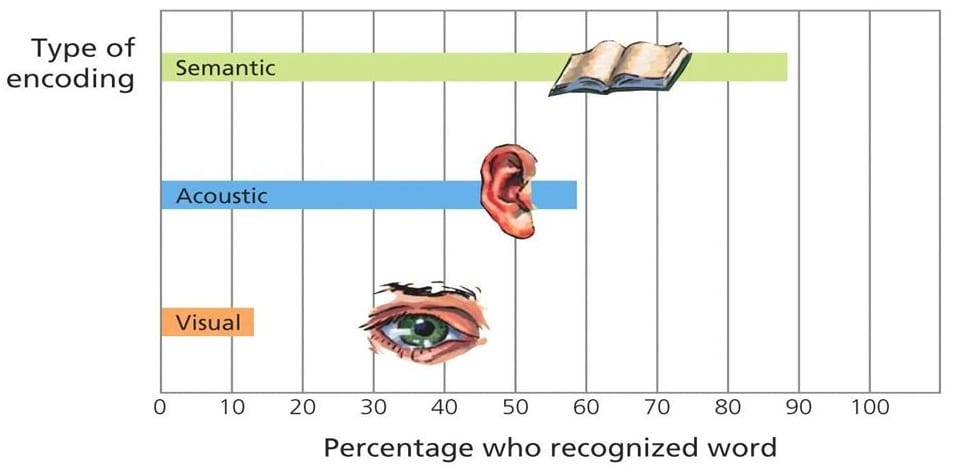Understanding the process of memorization opens many doorways to improved memorization techniques, to enhanced awareness of mental processes and more effective lessons. So how does remembering happen?
The architecture of memory

Once a memory is created, it must be stored: first in the sensory stage; then in short-term memory; and for some memories in long-term memory. As there is no need for us to maintain everything in our brain, the different stages of human memory function as a sort of filter that helps to protect us from the flood of information that we’re confronted with on a daily basis.
ALL incoming information is held briefly (1/2 to 2 seconds) in Sensory Memory. Selective attention to specific environmental stimuli transfer it to short term memory. After that first flicker, the sensation is stored in short-term memory. Short-term memory has a fairly limited capacity; it can hold about SEVEN items for no more than 20 or 30 seconds at a time.
Important information is gradually transferred from short-term memory into long-term memory. The transfer of information to long-term memory for more permanent storage can be facilitated or improved by mental repetition of the information or, even more effectively, by elaborating it, giving it a meaning and associating it with other previously acquired knowledge. Motivation is also a consideration, in that information relating to a subject of strong interest to a person, is more likely to be retained in long-term memory.
Working memory plays big role in remembering as well. It is the active system that temporarily stores and manipulates information that is needed in the execution of complex cognitive tasks, such as learning, reasoning and comprehension. It keeps information active, binds and transfer information into more permanent stores and maintains goal relevant information while inhibiting goal irrelevant information.
Encoding
There are three ways of transfering new information into our memory:

Different encoding effects help to create a stronger memory trace as they activate the work of working memory, frontal lobe, more transmitters released.
- Elaboration — the development of an existing idea by incorporating new information to augment the idea. Therefore while teaching new vocabulary it’s better to teach also collocations, set expressions, the words of other parts of speech, learn not just wordlists, but create sentences.
- Organization and Structure — logically organized information is remembered better (that includes clear board work as well).
- Interpretation — much easier to memorize something when meaningful interpretation is possible, that’s why it is very important to relate the target language to students’ real life situations.
- Attention — when a person is not distracted by anything and pays attention just to the information which should be remembered, working memory is more engaged. Explain your students when they come to the lesson that they should forget about their work, some problems waiting for them outside the classroom; create a learning atmosphere without any distractions.
- Levels of Processing — deeper levels of analysis produce more elaborate, longer-lasting, and stronger memory traces than shallow levels of analysis.
- Visual Imagery — use a lot of pictures, flashcards and videos in the lesson. Words actually don’t exist to our brains, at any rate. We DON’T REMEMBER words as a series of letters. We SEE and remember them as pictures. if information is presented orally, we remember about 10% three days later. However, if a picture is added in, that figure goes up to 65%. People can remember more than 2500 images with at least 90 percent accuracy for days after initial exposure. The key here is that we remember pictures with far greater ease than text.
- Spacing Effect — is the phenomenon whereby learning is greater when studying is spread out over time, as opposed to studying the same amount of content in a single session. That is, it is better to use spaced presentation rather than massed presentation. Practically, this effect suggests that intense, last-minute studying the night before an exam is not likely to be as effective as studying at intervals in a longer time frame. It challenges the learner but leads to better learning in the long-run.
- Generation Effect — a phenomenon where information is better remembered if it is generated from one’s own mind rather than simply read. Thus students remember better the vocabulary, definitions of which they have “discovered” themselves rather than just reading them.
After encoding the memory trace:
- can be stabilized (consolidated)
- weakened
- strengthened
- changed
Factors that affect consolidation (the process by which a temporary, labile memory is transformed into a more stable, long-lasting form) are:
- Emotions — emotionally charged events are remembered better; positive memories contain more contextual details (which in turn, helps memory). What should a teacher remember? It’s important to create a positive atmosphere in the lesson, students should get positive emotions, feel relaxed and safe.
- Rest — at least 10 minutes of resting after encoding is necessary. Common estimates for sustained attention (attention span) to a freely chosen task range from about 5 minutes for a two-year-old child, to a maximum of around 20 minutes in older children and adults. Therefore alter activities, have an activity involving active brain work followed by a “relaxed” activity.
- Sleep — things encoded just before sleeping are remembered better as while sleeping you don’t produce new memory traces so nothing interferes consolidation of older memories. The impact of sleeping is greater for negative scenes than for neutral ones. In general, people remember negative things BETTER.
- It might seem strange but smells and stress help to remember better as they arise more stimuli and improve consolidation.
- Primacy Effect and the Recency Effect — is the observation that information presented at the beginning (Primacy) and end (Recency) of a learning episode tends to be retained better than information presented in the middle. Plan to introduce the target language at the beginning of the lesson and don’t forget to do the review of the lesson material at the end.
That’s how we encode information. How we not to forget the information find here and here.
What helps you to remember the information better?






 Вероника Аветисян
Вероника Аветисян 
 Маргарита Аветисян
Маргарита Аветисян 


